|
|
Welcome to the Winter 2022/23 edition of the newsletter to keep you updated on the Twyni Byw - Sands of LIFE Project.
Here are some highlights of the autumn and winter work season, and plans for the coming months...
|
|
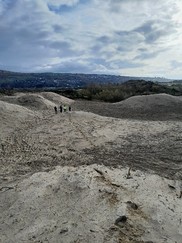
We’ve reached an important milestone at Morfa Harlech, thanks to the completion of the work to transform 16.5 hectares of mature, commercial forestry plantation to open sand dune.
This landscape-scale restoration is down to 4 years of hard work by the NRW Sands of LIFE, Forestry and Land Management Teams. Thanks also go to Royal St David’s Golf Club for their support.
7ha of the plantation was felled back in 2015, followed by a further 9.5ha in 2022 - all of which has been sold into the timber market. We’ve also removed 5.5ha of stumps, 13ha of brash, 14ha invasive species and created nearly 6ha of bare sand habitat.
Through their 50-year life the conifers changed the condition of the dunes soils significantly, so radical restoration of this type requires plenty of follow up maintenance. We are also working with colleagues to explore if we can introduce grazing on the site for long-term sustainability. Native woodland will now develop in the lea of the dunes, creating a natural transition to the woodland further inland.
|
|
|
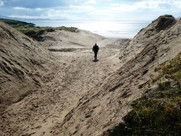
In September, at Aberffraw Common on Anglesey, Sands of LIFE excavated a dune ‘notch’ - a V-shaped gap in the frontal dune ridge.
This has created new bare sand habitat, which allows the dunes to move in a natural way and increases calcium-rich ‘sand rain’ to flowering grassland nearby. This gives a boost to rare invertebrates, and specialist plant species in an area where the dunes have become excessively stabilised and covered with vegetation over time.
|
|
|
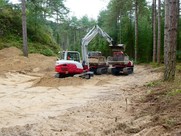
In the open glades of Newborough Forest, the project has rejuvenated 5 wetland areas, totalling over 6ha, which have been suffering from excess vegetation, invasive alien species and lowered water levels:
- Existing and new pools at Pant Mawr and Hendai have been scraped to increase depth and create gentle sloping sides.
- At Pant Bodowen, Ffrydiau and Gull Slack the damp, dune slack habitat has been scraped back to bare sand, which will hold more water in winter and spring and create a pioneer habitat for rare species to colonise.
This work will help to rare plants such as Shore Dock and a range of scare mosses and liverworts to thrive, as well as improving conditions for the site’s population of Great Crested Newts which are a European protected species. The pools will also provide a more reliable source of water for grazing livestock.
On the Newborough Warren, Sands of LIFE have recently fenced around 4km on the southern and western part of the dunes. This brings the total of new fencing completed to 8km.
The old fence was in disrepair, so replacing it allows the site to be grazed by sheep as well as cattle and ponies; whilst ensuring all the livestock are safe. Extensive grazing has a positive impact on dune habitats and associated wildlife by keeping grassland open, creating bare sand patches and limiting the development of excessive scrub and dense vegetation.
|
|
|

Works to reduce the amount of sea buckthorn growing on the dunes has continued this autumn at Pembrey Burrows and Laugharne-Pendine Burrows. Sea buckthorn is an alien species in this part of the UK, and had infested many hectares of dune across South Wales. As well as creating impassable thorny thickets, its presence is a threat to dune grasslands because of its sand binding and nitrogen fixing habit.
At Pendine Range smaller clumps of sea buckthorn growth were sprayed with herbicide, across 37ha. In addition, nearly 4 hectares of dense sea buckthorn scrub was removed by pulling it from the ground using a special ‘grab’ tool attached to an excavator.
|

At Pembrey Burrows contractors cleared dense areas of sea buckthorn using an excavator to strip away the roots and create new areas of bare sand habitat. These scrapes will provide a boost for our rare species that favour crucial open conditions. Smaller, scattered growth of buckthorn was sprayed with herbicide across 80ha on site.
|
|
|
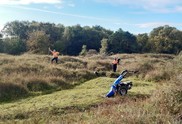
Autumn/winter 2022 marked our third year of dune grassland mowing at Whiteford Burrows, Kenfig and Merthyr Mawr. This vastly improves the quality of the habitat.
Sand dunes need nutrient poor soils to support wildlife; and so mowing and the removal of any cuttings reduces nutrient levels, giving lower growing flowering plants, such as the fen orchid, a chance to thrive by reducing competition. Mowing also encourages rabbit grazing which in turn helps keep the sward low over time.
|
|
|
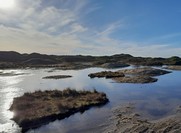
A new 0.7ha dune slack has been excavated at Kenfig National Nature Reserve. Slacks are low-lying areas in the dunes that are flooded in winter and marshy in summer. These unique wetland habitats are ideal for a range of dune specialist plants, particularly orchids.
The area where the slack was created was previously cleared by Sands of LIFE from encroaching scrub in 2019, and it is now hoped that the very rare fen orchids recorded nearby will colonise this new slack in the future.
In addition, 8 dry, bowl-shaped sand scrapes (or ‘blow outs’) with a total area of 1.3ha, were restored in autumn. The excavators are back on site now, to complete the second phase of scraping on around a further 1ha. The work will ensure a fresh supply of sand in the foredunes and will create much needed bare sand habitat that pioneer species rely upon.
|
|
|
|
Further works are planned for February 2023 at Whiteford Burrows following the conifer removal last winter. The works will include clearance of wind-blown trees and fallen brash, as well as scrub removal from dune slacks. We will be using some of the brash and timber to create new homes for rabbits out on the dunes in a bid to increase their numbers, as rabbits act as natural habitat engineers, supporting a healthy ecosystem.
|
|
|
Head over to our website for all the latest news about the project and information on results and findings. Or why not follow us on social media? Our Facebook, Instagram and Twitter feeds are updated regularly, providing sneak peaks of the weekly progress, outstanding dune related photos and short interview snippets.
|
|
 |
|
SoLIFE: LIFE 17 NAT/UK/000023
The Twyni Byw-Sands of LIFE project has received funding from the LIFE Programme of the European Union
Part funded by Welsh Government
|
|
|
|
|
|